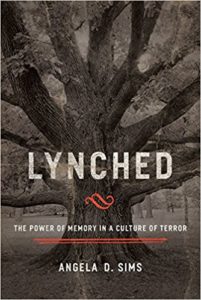Review of Angela D Sims’ Lynched: The Power of Memory in a Culture of Terror, by Mitzi J. Smith
 Throughout our history, the dominant culture has created a culture of terror in tandem with an ideology of inferiority and a mythological (as in fictional) fear of black bodies that has resulted in state sanctioned lynching and neo-lynching of black men, women, children and some of their allies. Dr. Sims’s book Lynched connects these dots, demonstrating a trajectory from a not so distant past to the present. It has always been necessary for black people to say that black lives matter. Lynched represents the culmination of qualitative research; Dr. Sims sat with and listened to black people telling their truth and painfully re-membering what it was like to live in a culture of terror characterized by the lynching of black bodies. Those who choose to participate, to be interviewed testified to what they saw and felt, as well as what they were made to feel but did not see with their own eyes. Black people were subjected to surveillance and the constant threat that they could be the next strange fruit hanging from popular trees. Dr. Sims calls these acts of remembering and of testifying prophetic practice. Dr. Sims is like Ezekiel asking can these bones live and speak. And they do speak! Sims embodied the spirit of Ezekiel: for almost two years (from July 2009 to Feb 2011) she attempted to breathe life into a southern valley full of dry unburied bones, to resurrect that from which many black people would rather avert their gaze rather than re-member. Not because they lacked the courage to tell the story but in order to safeguard their own well-being. “Silence is not necessarily acquiescence to things as they are but rather a contextual response to preserve life” (22) and perhaps sanity and one’s ability to love. Dr. Sims worked to connect the bones and to put flesh and tendons and skin so that they might live and speak a necessary truth. Through the power of memory, provoked memory, Sims gave space and the possibility of voice out of silence. And what the survivors, if I may call them that, testify about the miraculous faith of a terrorized people.
Throughout our history, the dominant culture has created a culture of terror in tandem with an ideology of inferiority and a mythological (as in fictional) fear of black bodies that has resulted in state sanctioned lynching and neo-lynching of black men, women, children and some of their allies. Dr. Sims’s book Lynched connects these dots, demonstrating a trajectory from a not so distant past to the present. It has always been necessary for black people to say that black lives matter. Lynched represents the culmination of qualitative research; Dr. Sims sat with and listened to black people telling their truth and painfully re-membering what it was like to live in a culture of terror characterized by the lynching of black bodies. Those who choose to participate, to be interviewed testified to what they saw and felt, as well as what they were made to feel but did not see with their own eyes. Black people were subjected to surveillance and the constant threat that they could be the next strange fruit hanging from popular trees. Dr. Sims calls these acts of remembering and of testifying prophetic practice. Dr. Sims is like Ezekiel asking can these bones live and speak. And they do speak! Sims embodied the spirit of Ezekiel: for almost two years (from July 2009 to Feb 2011) she attempted to breathe life into a southern valley full of dry unburied bones, to resurrect that from which many black people would rather avert their gaze rather than re-member. Not because they lacked the courage to tell the story but in order to safeguard their own well-being. “Silence is not necessarily acquiescence to things as they are but rather a contextual response to preserve life” (22) and perhaps sanity and one’s ability to love. Dr. Sims worked to connect the bones and to put flesh and tendons and skin so that they might live and speak a necessary truth. Through the power of memory, provoked memory, Sims gave space and the possibility of voice out of silence. And what the survivors, if I may call them that, testify about the miraculous faith of a terrorized people.
Understandably, everybody did not want to talk or to recall the evil of lynching. Sims states that “lynching [unlike the Jewish Holocaust] continues to be associated with shame and denial—shame embodied by one too many who lived under this regime of terror, and denial by one too many who refute evidence preserved on postcards and other visual depictions” (32). Black people are constantly asked to forget—to forget about slavery, about lynching, about racism and its exigencies, as if forgetting is the way to heal and to have peace. The human mind is not made to forget but to remember. Suppressed memory haunts and continues to terrorize in some form. Black people are asked to forget slavery, lynching, Jim/Jane Crow, and disenfranchisement and to act as if systemic racism does not exist. But nobody is asked to forget the Holocaust or the civil war and so on. Lynched values the power of memory and refuses to allow this story (and present) of legally sanctioned domestic terrorism against black bodies to be buried. Until all crime receives the same focus and assignment of resources to deter and prevent, there can be no constructive national dialogue and peaceful co-existence.
Dr. Sims compares her task as interviewer-listener to someone tip-toeing through a minefield of IEDs (improvised explosive devices). Given the age and violent nature of the experience of domestic terrorism meant to create a culture of terror and fear, Sims was careful not to detonate “life-negating triggers associated with long-term suppression of traumatic events” (37). Dr. Sims is a curator of embodied truth-telling narratives, and she empathetically engages with respect, care and grace. Elder Willie Matthew Thomas of Birmingham, Alabama, for example, courageously re-membered as a preteen waiting for his uncle and being approached by six to eight white men who questioned his being “out here.” The white men were unsuccessful in their attempts to command their dogs to bite the eleven-year-old; they accuse the young boy of messing with white women and threatened to hang him. Fighting for his life young Willie thought to mention his granddaddy who lives close by—surely, they know him. Sims observes that respectability politics then (and now) could not save black bodies from white terror.
Many black people knew, saw or heard of somebody who had been lynched. Many of my generation know/heard of Emit Till but we never saw the mangled, unrecognizable black bodies hanging from trees or pulled out of swamps. But the miracle is that despite the hate that black peoples endured, many refused to be consumed by the same hate that fueled the perpetrators and those who were complicit. Dr. Sims states that “African Americans who remember lynching share life-preserving insights on ways in which they navigated land mines designed to infuse them with hatred” (43). In order to preserve their own well-being, they choose not to hate those who hated and terrorized them simply because of the color of their skin. The victims of domestic terrorism in a time when lynching was the weapon of choice (1890-1950), black victims of domestic terrorism chose to understand the terror as a product of racism. Their faith in God allowed them to process the hate without hating. I do think today that we expect victims of neo-lynching to skip to forgiveness without first processing grief or completing the grieving process. And if black victims forgive and move on, it becomes unnecessary or not a matter of urgency to change the system. God was their source and gave them strength to endure. It is difficult to believe that everyone who lived through the culture of terror produced through lynching of black bodies reached the same faith conclusion as Dr. Sim’s interviewees. But we don’t have those voices; perhaps, they are among some of those who are no longer living or who refused to be interviewed. Everybody of faith does not survive or survive with all of their sanity (spiritual or mental) preserved. There is a danger in viewing those who choose to hate their terrorists or who take some time in arriving at forgiveness as if their faith is faulty or is not faith. Faith can motivate to give up one’s life for God and yet feel forsaken by God: My God, my God why have you forsaken me?
Another of Dr. Sims’ interviewees, Pastor Hartsfield, states that injustice is the symbol of lynching, which suggests the need for the church to be prophetic. Dr. Sims prophetically connects the culture of terror produced by lynching with contemporary forms of lynching, like the killings of Trayvon Martin and Michael Brown. “Any discussion about lynching should be intricately connected to practices of justice that critique and call into question US policies that reject the validity that black lives are of importance” (70). Dr. Sims aptly writes that “even if trees no longer bear strange fruit, a proliferation of stand-your-ground legislation in multiple states and racial disparities within the United States’ incarceration system suggests that black people remain in the shadow of the lynching tree” (64). Today the strange fruit lays on the cold ground for hours like a rotten apple, or is bruised and left to rot in a jail cell for failure to signal, or is shot down in a park holding a bb gun and left to die on the ground like rotten fruit. The tree is a symbol of the unjust killing of black people as if they are nothing more than disposable, rotten fruit, and for that they deserve to die. As Sims puts it, black bodies are treated as “dispensable commodities,” disavowed as neighbor. Dr. Sims powerfully states that “A mandate to treat others as we wish to be treated is often little more than a mythical mental configuration void of any correlation to reality” (80-81). (Neo)Lynching is a national sin and an evil that persists in the twenty-first century as black lives continue to be devalued. Lynched demonstrates the necessity of telling our truths, that truth-telling is not the absence of love, and that reconciliation and the dismantling of oppressive structures requires truth-telling, not matter how ugly. There is no shame in telling and retelling our truths.
The Rev. Dr. Mitzi J. Smith, PhD, is Professor of New Testament and Early Christian Studies at Ashland Theological Seminary, where she has taught primarily in the Detroit Center for over ten years. She is the author of four published books and a number of essays. Her latest two books are Insights from African American Interpretation (Fortress 2017) and I Found God in Me. A Womanist Biblical Hermeneutics Reader (Cascade, 2015). Dr. Smith also has two upcoming books: Toward Decentering the New Testament (Cascade 2018) and Womanist Sass and Talk Back (Cascade 2018).

